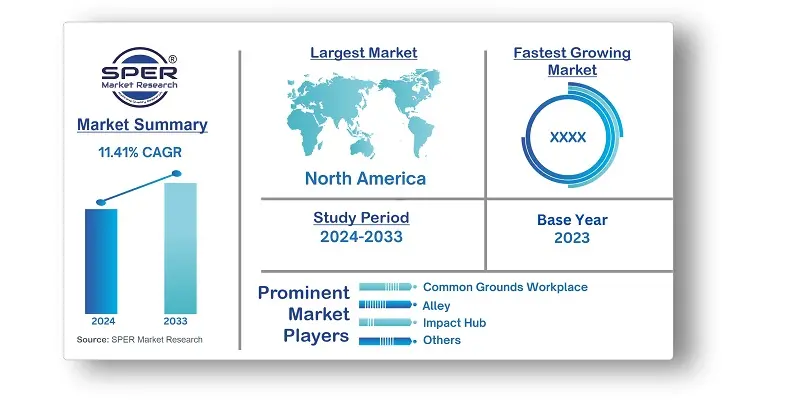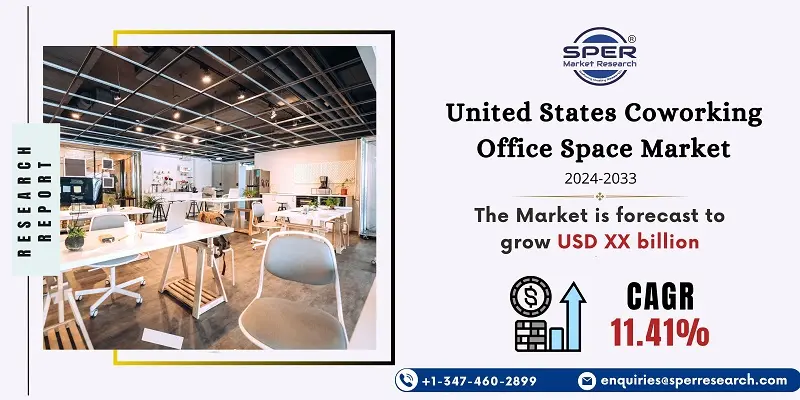
United States Coworking Office Space Market Growth, Size, Trends, Share and Future Outlook
United States Coworking Office Space Market Size- By Type, By Application, By End User- Regional Outlook, Competitive Strategies and Segment Forecast to 2033
| Published: Jul-2024 | Report ID: FMCG24133 | Pages: 1 - 106 | Formats*: |
| Category : Consumer & Retail | |||
- December 2021; Commercial real estate firm WeWork and data science talent and location platform Vertis have formed a strategic alliance. Through the use of data, this alliance seeks to assist members in overcoming some of the most challenging workplace-related obstacles, such as figuring out which target markets have rising talent pools and how employee commute times affect productivity.
- January 2021; Venture X, a cutting-edge office space, has announced the launch of Venture X Denver-Five Points, its newest location in Denver, Colorado. Situated in the Lydian building at 2590 Welton Street, Ste. 200, this 14,500-square-foot office is a women-owned franchise location and the second Venture X facility in Denver.


| Report Metric | Details |
| Market size available for years | 2020-2033 |
| Base year considered | 2023 |
| Forecast period | 2024-2033 |
| Segments covered | By Type, By Application, By End Use |
| Regions covered | Northern, Southern, Western, Eastern |
| Companies Covered | Alley, Common Grounds Workplace, Impact Hub, Industrious Office, Office Evolution, Regus, Serendipity Labs, Spaces, The Yard, WeWork. |
- Freelancers
- Startups
- Small Businesses
- Remote Workers
- Entrepreneurs
- Digital Nomads
| By Type: |
|
| By Application: |
|
| By End Use: |
|
- United States Coworking Office Space Market Size (FY’2024-FY’2033)
- Overview of United States Coworking Office Space Market
- Segmentation of United States Coworking Office Space Market by Type (Flexible Managed Office, Serviced Office)
- Segmentation of United States Coworking Office Space Market by Application (Information Technology, Legal Services, BFSI)
- Segmentation of United States Coworking Office Space Market by End Use (Small Scale Company, Large Scale Company, Personal User, Others)
- Statistical Snap of United States Coworking Office Space Market
- Expansion Analysis of United States Coworking Office Space Market
- Problems and Obstacles in United States Coworking Office Space Market
- Competitive Landscape in the United States Coworking Office Space Market
- Impact of COVID-19 and Demonetization on United States Coworking Office Space Market
- Details on Current Investment in United States Coworking Office Space Market
- Competitive Analysis of United States Coworking Office Space Market
- Prominent Players in the United States Coworking Office Space Market
- SWOT Analysis of United States Coworking Office Space Market
- United States Coworking Office Space Market Future Outlook and Projections (FY’2024-FY’2033)
- Recommendations from Analyst
1.1. Scope of the report1.2. Market segment analysis
2.1. Research data source
2.1.1. Secondary Data2.1.2. Primary Data2.1.3. SPER’s internal database2.1.4. Premium insight from KOL’s
2.2. Market size estimation
2.2.1. Top-down and Bottom-up approach
2.3. Data triangulation
4.1. Driver, Restraint, Opportunity and Challenges analysis
4.1.1. Drivers4.1.2. Restraints4.1.3. Opportunities4.1.4. Challenges
4.2. COVID-19 Impacts of the United States Coworking Office Space Market.
5.1. SWOT Analysis
5.1.1. Strengths5.1.2. Weaknesses5.1.3. Opportunities5.1.4. Threats
5.2. PESTEL Analysis
5.2.1. Political Landscape5.2.2. Economic Landscape5.2.3. Social Landscape5.2.4. Technological Landscape5.2.5. Environmental Landscape5.2.6. Legal Landscape
5.3. PORTER’s Five Forces
5.3.1. Bargaining power of suppliers5.3.2. Bargaining power of buyers5.3.3. Threat of Substitute5.3.4. Threat of new entrant5.3.5. Competitive rivalry
5.4. Heat Map Analysis
6.1. United States Coworking Office Space Market Manufacturing Base Distribution, Sales Area, Product Type6.2. Mergers & Acquisitions, Partnerships, Product Launch, and Collaboration in United States Coworking Office Space Market
7.1. United States Coworking Office Space Market Size, Share and Forecast, By Type, 2020-20267.2. United States Coworking Office Space Market Size, Share and Forecast, By Type, 2027-20337.3. Flexible Managed Office7.4. Serviced Office
8.1. United States Coworking Office Space Market Size, Share and Forecast, By Application, 2020-20268.2. United States Coworking Office Space Market Size, Share and Forecast, By Application, 2027-20338.3. Information Technology8.4. Legal Services8.5. BFSI
9.1. United States Coworking Office Space Market Size, Share and Forecast, By End Use, 2020-20269.2. United States Coworking Office Space Market Size, Share and Forecast, By End Use, 2027-20339.3. Small Scale Company9.4. Large Scale Company9.5. Personal User9.6. Others
10.1. United States Coworking Office Space Market Size and Market Share
11.1. United States Coworking Office Space Market Size and Market Share By Region (2020-2026)11.2. United States Coworking Office Space Market Size and Market Share By Region (2027-2033)11.3. Eastern11.4. Western11.5. Northern11.6. Southern
12.1. ALLEY
12.1.1. Company details12.1.2. Financial outlook12.1.3. Product summary12.1.4. Recent developments
12.2. COMMONGROUNDS WORKPLACE
12.2.1. Company details12.2.2. Financial outlook12.2.3. Product summary12.2.4. Recent developments
12.3. IMPACT HUB
12.3.1. Company details12.3.2. Financial outlook12.3.3. Product summary12.3.4. Recent developments
12.4. INDUSTRIOUS OFFICE
12.4.1. Company details12.4.2. Financial outlook12.4.3. Product summary12.4.4. Recent developments
12.5. OFFICE EVOLUTION
12.5.1. Company details12.5.2. Financial outlook12.5.3. Product summary12.5.4. Recent developments
12.6. REGUS
12.6.1. Company details12.6.2. Financial outlook12.6.3. Product summary12.6.4. Recent developments
12.7. SERRENDIPITY LABS
12.7.1. Company details12.7.2. Financial outlook12.7.3. Product summary12.7.4. Recent developments
12.8. SPACES
12.8.1. Company details12.8.2. Financial outlook12.8.3. Product summary12.8.4. Recent developments
12.9. WEWORK
12.9.1. Company details12.9.2. Financial outlook12.9.3. Product summary12.9.4. Recent developments
12.10. Others
SPER Market Research’s methodology uses great emphasis on primary research to ensure that the market intelligence insights are up to date, reliable and accurate. Primary interviews are done with players involved in each phase of a supply chain to analyze the market forecasting. The secondary research method is used to help you fully understand how the future markets and the spending patterns look likes.
The report is based on in-depth qualitative and quantitative analysis of the Product Market. The quantitative analysis involves the application of various projection and sampling techniques. The qualitative analysis involves primary interviews, surveys, and vendor briefings. The data gathered as a result of these processes are validated through experts opinion. Our research methodology entails an ideal mixture of primary and secondary initiatives.



Frequently Asked Questions About This Report
PLACE AN ORDER
Year End Discount
Sample Report
Pre-Purchase Inquiry
NEED CUSTOMIZATION?
Request CustomizationCALL OR EMAIL US
100% Secure Payment






Related Reports
Our Global Clients
Our data-driven insights have influenced the strategy of 200+ reputed companies across the globe.




















